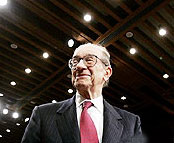|
 |
| Alan Greenspan
is juggling conflicting
data |
The US Federal Reserve has maintained its "measured" pace of interest
rate rises, raising the cost of borrowing by 25 basis points to 3.25%.
It was the ninth monthly rise in a row by the Fed's Open Market
Committee.
Analysts had widely expected the move as the Fed
tries to maintain economic growth but keep a lid
on inflation.
The economy has fared well with 3.8% growth in the first three months
of the year, but rising oil prices have stoked inflation fears.
The recent cycle of increases has seen US rates gradually rise from
50-year lows of 1% set in 2002.
Rising US interest rates mean better returns for investors buying
assets priced in dollars, thus pushing up the value of the US currency.
Although energy prices have risen further, the [economic] expansion
remains firm and labour market conditions continue to improve gradually
Analysts had widely predicted the increase, but some voiced surprise
that there was no hint from that the Fed was nearing the end of its
current rate tightening cycle.
"It seems as though the Fed was suggesting that inflation pressures are
very short term. That could be a hint that everything's under control
right now," John Hughes, managing director of Epiphany Equity Research
said.
Jeffrey N Kleintop, chief investment strategist at PNC advisors added:
"Investors wanted to see that the Fed was going to say something that they
were close to being finished."
The Fed's statement that accompanied its decision said that even with
the rise in energy prices the economy has continued to grow at a
respectable pace.
"Although energy prices have risen further, the expansion remains firm
and labour market conditions continue to improve gradually," it said.
It added that pressures on inflation "have stayed elevated" -
acknowledging crude's recent rise to above the $60 a barrel level - but
also reiterated its belief that "longer-term inflation expectations remain
well contained".
Data released ahead of the decision revealed a fall of 6,000 in
unemployment claims last week - the second weekly fall in a row - could be
a signal that the economy remains healthy.
Meanwhile personal income growth slowed sharply - rising just 0.2% in
May, compared with a 0.6% rise in April.
But, at the same time, consumer spending was unchanged in May after a
rise of 0.6% in April. Experts attributed the slowdown to unusually cold
weather which kept people away from the shops.
Among the other factors affecting the Fed's decision were fears in some
quarters of a housing bubble.
Rock-bottom interest rates have helped drive a
boom in house prices as homeowners remortgage
their properties and - frequently - increase their
borrowing to fund consumer spending or home improvements.
Some fear, however, that the rapid house price inflation could prove
unsustainable.
Fed chairman Alan Greenspan has denied a national bubble but
acknowledged that some locations may be at risk.
(BBC) | 